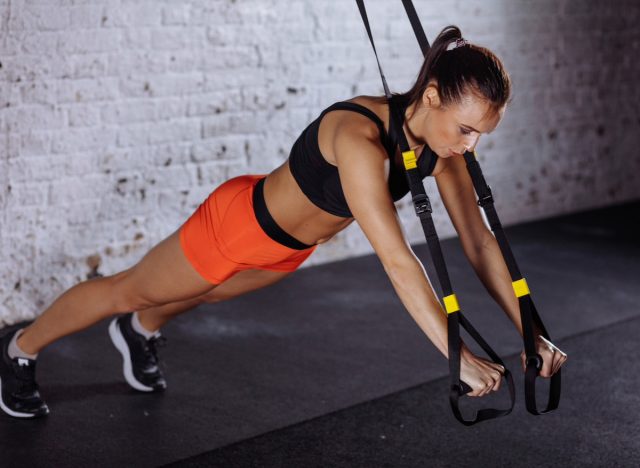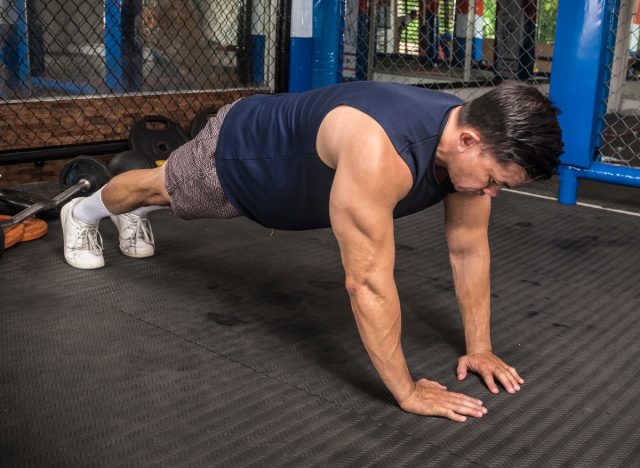4 Push-Up Variations That Build Elite Upper Body Strength, According to Trainers

Push-ups are more than a warm-up or finisher. They’re a brilliant blueprint for building elite upper-body strength without needing a single machine. They teach your body to move as a unit. They train the muscles that matter: chest, shoulders, triceps, and core, while improving control, stability, and muscular endurance.
The beauty of the push-up is its adaptability. With a few potent variations, it can evolve from a basic bodyweight move into a serious strength-building tool. If you’re training at home, in a garage gym, or simply want to improve your appearance and mobility, these four push-up variations have consistently delivered results for my clients, and they’ll do the same for you.
4 Push-Up Variations That Build Serious Upper Body Strength
Push-Up #1: Weighted Push-Ups

Adding weight to a push-up turns it into a serious strength builder. You recruit more muscle from your chest, triceps, and shoulders, while your core works harder to maintain spinal alignment under load. I’ve worked with athletes in their 40s and 50s who couldn’t bench press due to shoulder discomfort, but saw measurable strength gains after replacing it with weighted push-ups.
How to Do It:
- Strap on a weight vest or carefully place a weight plate across your upper back (have a partner assist if needed).
- Set up in a push-up position with your hands slightly wider than shoulder-width, with your wrists stacked under your elbows.
- Brace your core, squeeze your glutes, and keep your body in a straight line from head to heels.
- Lower your chest to about an inch from the floor, keeping your elbows at a 45-degree angle to your sides.
- Drive through your palms and push back to the starting position with full-body tension.
Recommended Sets and Reps: Knock out 3 to 4 sets of 6 to 10 reps. Rest for 60 to 90 seconds between each set.
Trainer Tip: Keep your hips from sagging by driving your ribs down and locking in your abs throughout the entire set.
Push-Up #2: TRX or Ring Push-Ups

Suspension push-ups crank up the difficulty by introducing instability. Your core, chest, and scapular stabilizers have to work overtime to keep your body aligned as the straps move. You also experience a deeper stretch in your pectorals, which leads to improved muscle recruitment. One of my clients, who is intense with traditional push-ups, could barely manage six ring push-ups at first. Now he uses them weekly to keep his shoulders strong and his upper body in shape.
How to Do It:
- Set the TRX straps or rings so that the handles hang at mid-shin height.
- Grip the handles, walk your feet back, and extend your arms so you’re in a suspended plank.
- Keep your wrists neutral and shoulders pulled down away from your ears.
- Lower your chest slowly between the handles, allowing your hands to spread slightly as you descend.
- Pause at the bottom, then press back up, keeping your body rigid and level.
Recommended Sets and Reps: Knock out 3 to 4 sets of 8 to 12 reps. Rest for 60 seconds between each set.
Trainer Tip: Drive down through the handles to push your body up.
Push-Up #3: Close-Grip Push-Ups

This variation is a triceps powerhouse. By narrowing your hand position, you reduce chest involvement and overload your arms and front delts. You also strengthen your core and shoulder stabilizers because a tighter position makes balance harder. Many of my clients who wanted stronger arms saw more improvement from these than from dips or overhead presses alone.
How to Do It:
- Set up in a high plank with your hands directly under your shoulders or slightly closer together.
- Engage your core and glutes to keep a straight line from head to heels.
- Lower your chest between your hands, keeping your elbows tucked tight to your ribs.
- Pause one inch above the ground, then press back up through the base of your palms.
- Keep your arms close to your body throughout the entire rep.
Recommended Sets and Reps: Knock out 3 sets of 10 to 15 reps. Rest for 45 to 60 seconds between each set.
Trainer Tip: Avoid letting your elbows flare out. Maintain a strict and tight movement to maximize triceps activation.
Push-Up #4: Elevated Push-Ups (Hands Elevated)

Elevating your hands on bumper plates, dumbbells, or parallettes creates a deeper range of motion at the bottom of the push-up. That added stretch builds more tension through your chest and shoulders, leading to increased strength and hypertrophy over time. It’s one of the simplest ways to make push-ups harder, without adding weight.
I use this variation with clients who have already mastered strict push-ups and are looking for the next challenge. One man in his early 40s told me regular push-ups “just weren’t doing much anymore.” After switching to elevated push-ups on parallel bars, his chest strength noticeably improved, and he felt sore in new areas, especially the lower portion of the press. That deeper range hits muscles that standard push-ups often miss.
How to Do It:
- Place two bumper plates, hex dumbbells, or parallettes on the floor about shoulder-width apart.
- Place your hands on the elevated surface and set up in a strong push-up position—hands under shoulders, body in a straight line from head to heels.
- Brace your core, squeeze your glutes, and lower your chest down slowly between your hands.
- Descend as deep as your mobility allows, ideally until your shoulders are in line with or slightly below your hands.
- Press back up to full extension, keeping your body tight and controlled.
Recommended Sets and Reps: Knock out 3 to 4 sets of 8 to 12 reps. Rest for 60 seconds between each set.
Trainer Tip: Keep your elbows at a 45-degree angle and move with control. Don’t bounce out of the bottom.
Final Takeaway
Push-ups remain one of the most valuable tools for building upper-body strength at any age. But if your goal is elite-level performance, you need variations that challenge your muscles, improve control, and demand full-body effort. Weighted push-ups build raw strength. TRX and ring push-ups test your stability. Close-grip push-ups sharpen arm power. Elevated push-ups target your upper chest and shoulders.
Use these variations intentionally. Add them to your workouts two to three times per week, focus on clean form and progression, and you’ll build upper body strength that holds up anywhere.